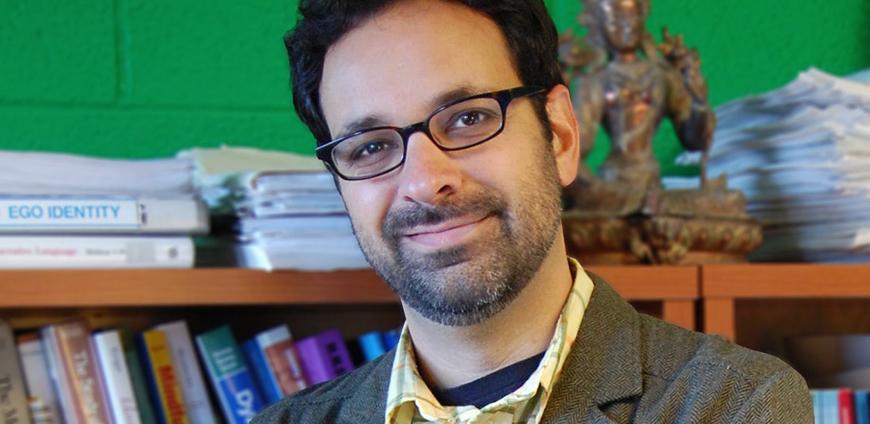 Photo by Amelie Hyams, 2015
Photo by Amelie Hyams, 2015
There is an old, familiar saying, “we are the hero of our own story” (Mary McCarthy). But what if our story was written with someone else in the lead role?
Professor Moin Syed, from the Department of Psychology, knows that the script for our story has already been written for us. He is researching a concept called the Master Narrative, which is particularly powerful in American culture.
“The American dream: success through hard work, determination, going to school, going to college, choosing a major, getting a career, getting married, having a child, buying a house – that’s a Master Narrative. It’s a script that tells us how to live our life.”
Syed tells us that we adopt the story and these plans unconsciously making them our own. We compare our life against the script, usually without even noticing we are doing so. For most of us, the Master Narrative is a pretty good story line to follow. But what if we don’t fit the plan? What if we don’t want to follow this script?
If you don’t fit the Master Narrative, it becomes a challenge for you. Syed explains, “There are all these societal level attitudes and belief structures that we as individuals have to interact with.” There is an expectation of what being an American is. There is even “an idea about what a prototypical American looks like and what a foreigner looks like.”
People who are different from this image spark curiosity. It can be as simple as having what is perceived to be an unusual, “foreign-sounding” name. But always being asked about their background can be unsettling. It repeatedly sets them apart as “other.”
Syed knows first hand what this is like. He is often asked where he is from. He says that when he “answers ‘California’, they say, ‘where do you really come from?’ The implication is that you are not really an American.” Syed tells us this is referred to as “Perpetual Foreigner Syndrome.”
Referencing the Erika Lee profile (October 2015), Syed recalls how her family has been here for generations. But, he says, “I assume they still get that question, and often from people whose ancestors came here more recently.”
“Curiosity seems innocent but can sometimes not be perceived that way.” Syed tells us that “It’s an unconscious form of prejudice. . . They don’t understand why the person takes offense to such an innocent question.” People think the victim is being too sensitive, too politically correct. But Syed explains, “the perpetrator doesn’t understand that the target goes through this all the time.” They’re continually being reminded that they don’t fit the script.
Being out of step with the Master Narrative also means that you have to repeatedly find your place. Syed tells us that every time people change contexts — for example from home to high school and then on to college, etc. — they need to adjust to the new expectations. Being different from the expected image makes this process harder.
There are also a lot of conflicts that arise about attitudes towards cultural heritage and the difference between these and mainstream American culture, especially for kids from immigrant families. These kids have to find their way between sometimes-conflicting expectations.
“It leads to differences of opinion between parents and children about what the child should be doing. So this is really an identity issue.” Syed adds that, “If they are experiencing family conflict, they are doing more poorly in class,” which he says, “is not surprising.”
“If you look at the entire population of college students in this country, 75% of them could be considered non-traditional in some way. Our idea of a non-traditional college student has changed. The 18-22 year old, living on campus, white, middle class, that’s a very small percentage now. Our college students aren’t getting more diverse, they’ve been more diverse for a long time. There are a lot of people who come from poverty. They’re underrepresented, but they’re here.”
Cross discipline efforts are needed to more fully understand our students and to find the best ways to educate them. Syed wonders, “How do we teach about intercultural, interracial relations? How do we teach about our own history?” He reminds us how Erika Lee didn’t learn about her family’s part in American history, until she was in college.
“The purpose of grand challenges is to bring people from different disciplines and perspectives together, but this still relies on getting them together.” Interdisciplinary work is especially difficult, he explains, because of very different ways of thinking.
As an example Syed looks at how psychologists and sociologists are talking about the same things, but from different types of analysis. “When you can’t even agree on what constitutes evidence, it becomes very difficult to solve grand challenges.” But he and his colleagues are trying to bring some of these different disciplines together, “a little more.”
Syed is excited about a new project he is working on in collaboration with Colin DeYoung in psychology and Valerie Tiberius in philosophy. This work is focused on the development of virtue and on personality development. “One of my really passionate interests is trying to understand the different pathways of college students . . . different ways in which they try to figure out how to make a good life.”
He wonders “How do college students develop the best way they can, opposing that idea that there is one path and one way, or that there is a good way and a bad way?”
Part of the answer, he believes, is that we need to find a way to “support students from diverse backgrounds to have positive experiences and to feel that the way they are doing college is an okay way to do college too.” Recognizing that “There are many different definitions and different cultural definitions of what a good life is.”

